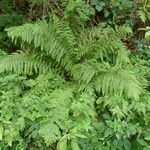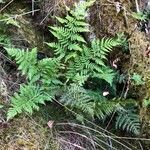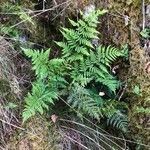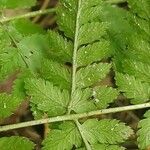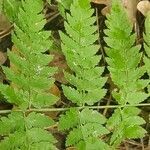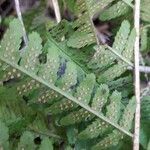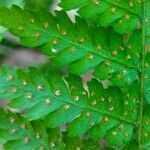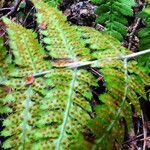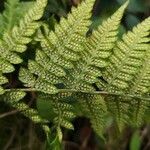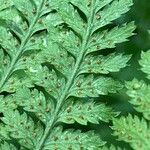Rhizome horizontal, short-creeping; lvs deciduous, essentially glabrous except for the chaffy, concolorous pale brown scales that beset at least the lower part of the petiole and sometimes also part of the rachis; petiole mostly a quarter to a third as long as the blade; blade 2–5+ dm, a third to half as wide, broadest a little below the middle, bipinnate-pinnatifid to tripinnate, with mostly 10–15 pairs of pinnae below the pinnatifid tip; pinnae (at least the lower ones) mostly oblique, the basal pinnule of the lower side of the lowest pinna longer than the one next to it and to twice (thrice) as long as the subopposite upper pinnule; ultimate segments finely spinulose-toothed; sori midway between the midvein and the margins; 2n=164. Moist or wet woods and swamps; interruptedly circumboreal, in Amer. s. to S.C., Ark., and Wash. (D. spinulosa; D. austriaca var. s.)
Leaves monomorphic, dying in winter, 15--75 × 10--30 cm. Petiole 1/4--1/3 length of leaf, scaly at least at base; scales scattered, tan. Blade light green, ovate-lanceolate, 2--3-pinnate-pinnatifid, herbaceous, not glandular. Pinnae ± in plane of blade, lance-oblong; basal pinnae lanceolate-deltate, slightly reduced, basal pinnules usually longer than adjacent pinnules, basal basiscopic pinnule longer than basal acroscopic pinnule; pinnule margins serrate, teeth spiny. Sori midway between midvein and margin of segments. Indusia lacking glands. 2 n = 164.
A small fern. It grows 60 cm high and spreads 30 cm wide. The fronds are triangle shaped in outline. They are delicate and divided 3 times. They are pale green in colour.
